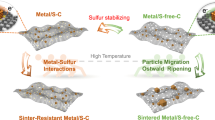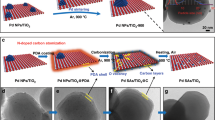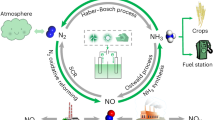Abstract
DURING recent studies of photo-adsorption on high area nickel oxide, decomposition of the oxide was observed at surprisingly low temperatures. Teichner1 first prepared this nickel oxide by decomposing Ni(OH)2 at 200° C for 2 h at a pressure of less than 10−5 mm mercury. It is yellow-green, with a surface area of approximately 100 m2g−1 and has a composition which is almost stoichiometric2. Both composition and area are little changed by further annealing under the same conditions, but on exposing the oxide to higher pressures of oxygen, it blackens instantly.
This is a preview of subscription content, access via your institution
Access options
Subscribe to this journal
Receive 51 print issues and online access
$199.00 per year
only $3.90 per issue
Buy this article
- Purchase on Springer Link
- Instant access to full article PDF
Prices may be subject to local taxes which are calculated during checkout
Similar content being viewed by others
References
Teichner, S. J., and Morrison, J. A., Trans. Farad. Soc., 51, 961 (1955).
Cotton, J. D., and Fensham, P. J., Trans. Farad. Soc., 59, 1444 (1963).
Imoto, T., Haramo, Y., and Nichi, Y., J. Chem. Soc. (Japan), 86, 694 (1965).
Fricke, R., Lehrmann, O., and Wolf, W., Z. Physik. Chemie (B), 37, 60 (1937).
Author information
Authors and Affiliations
Rights and permissions
About this article
Cite this article
LARKINS, F., FENSHAM, P. Decomposition of Nickel Oxide. Nature 215, 1268–1269 (1967). https://doi.org/10.1038/2151268a0
Received:
Revised:
Issue Date:
DOI: https://doi.org/10.1038/2151268a0
This article is cited by
-
Novel Ni cermets for anode-supported proton ceramic fuel cells
Journal of Solid State Electrochemistry (2019)
Comments
By submitting a comment you agree to abide by our Terms and Community Guidelines. If you find something abusive or that does not comply with our terms or guidelines please flag it as inappropriate.



